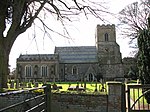Stow Bardolph railway station
Disused railway stations in NorfolkFormer Great Eastern Railway stationsPages with no open date in Infobox stationRailway stations in Great Britain closed in 1963Railway stations in Great Britain opened in 1846 ... and 2 more
Stow BardolphUse British English from November 2017

Stow Bardolph railway station, in the parish of Stow Bardolph, Norfolk, served the villages of Stow Bardolph and Stowbridge. It closed in 1963. The Lynn & Ely Railway Bill received the Royal Assent on 30 June 1845. Work started on the line in 1846 and the line and its stations were opened on 27 October 1846. Stow Station opened with the line and was situated South of Holme Gate Station and north of Downham Station. The line ran from Ely to Downham, the eventual destination being Ely.
Excerpt from the Wikipedia article Stow Bardolph railway station (License: CC BY-SA 3.0, Authors, Images).Stow Bardolph railway station
The Causeway, King's Lynn and West Norfolk Stow Bardolph
Geographical coordinates (GPS) Address Nearby Places Show on map
Geographical coordinates (GPS)
| Latitude | Longitude |
|---|---|
| N 52.6374 ° | E 0.3726 ° |
Address
The Causeway
The Causeway
PE34 3PH King's Lynn and West Norfolk, Stow Bardolph
England, United Kingdom
Open on Google Maps







